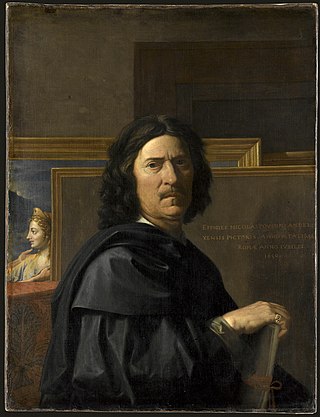
Nicolas Poussin was a French painter who was a leading painter of the classical French Baroque style, although he spent most of his working life in Rome. Most of his works were on religious and mythological subjects painted for a small group of Italian and French collectors. He returned to Paris for a brief period to serve as First Painter to the King under Louis XIII and Cardinal Richelieu, but soon returned to Rome and resumed his more traditional themes. In his later years he gave growing prominence to the landscape in his paintings. His work is characterized by clarity, logic, and order, and favors line over color. Until the 20th century he remained a major inspiration for such classically-oriented artists as Jacques-Louis David, Jean-Auguste-Dominique Ingres and Paul Cézanne.

Flora is a Roman goddess of flowers and spring – a symbol for nature and flowers. While she was otherwise a relatively minor figure in Roman mythology, being one among several fertility goddesses, her association with the spring gave her particular importance at the coming of springtime, as did her role as goddess of youth. She was one of the fifteen deities who had their own flamen, the Floralis, one of the flamines minores. Her Greek counterpart is Chloris.

Venus and Cupid with a Satyr is a painting by the Italian High Renaissance artist Antonio da Correggio. It is now in the Musée du Louvre in Paris.

Psyché is an opera in a prologue and five acts composed by Jean-Baptiste Lully to a libretto by Thomas Corneille. Based on the love story of Cupid and Psyche, Psyché was premiered on April 19, 1678 by the Académie Royale de Musique at the Théâtre du Palais-Royal in Paris.

Le Réveil de Flore, is a ballet anacréontique in one act, with choreography by Marius Petipa and music by Riccardo Drigo, to a libretto written by Petipa and Lev Ivanov. First presented by the Imperial Ballet at Peterhof Palace on 6 August [O.S. 25 July] 1894.

Pierre Julien was a French sculptor who worked in a full range of rococo and neoclassical styles.
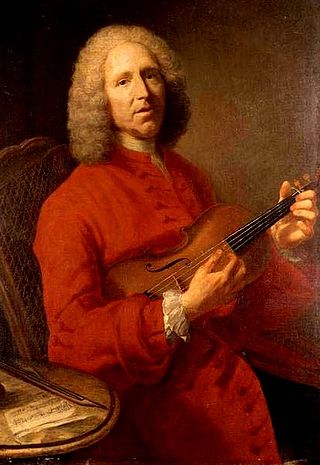
Zéphire is an opera by Jean-Philippe Rameau in the form of a one-act acte de ballet. Nothing is known about the date of its composition, and it was probably not performed in Rameau's lifetime. The name of its librettist is also unknown but may possibly have been Louis de Cahusac.
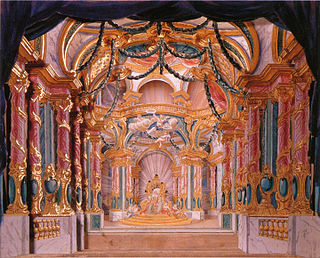
Les fêtes de Paphos is an opéra-ballet in three acts by the French composer Jean-Joseph Cassanéa de Mondonville. The work was described as a ballet héroïque on the title page of the printed score. Each act had a different librettist. Les fêtes de Paphos was first performed at the Académie royale de musique in Paris on 9 May 1758 and was a popular success. Mondonville recycled material from two of his previous operas for the first two acts, namely Erigone (1747) and Vénus et Adonis (1752), both originally composed for Madame de Pompadour's Théâtre des Petits Cabinets.

The Four Seasons was the last set of four oil paintings completed by the French painter Nicolas Poussin (1594–1665). The set was painted in Rome between 1660 and 1664 for the Duc de Richelieu, the grand-nephew of Cardinal Richelieu. Each painting is an elegiac landscape with Old Testament figures conveying the different seasons and times of the day. Executed when the artist was in failing health suffering from a tremor in his hands, the Seasons are a philosophical reflection on the order in the natural world. The iconography evokes not only the Christian themes of death and resurrection but also the pagan imagery of classical antiquity: the poetic worlds of Milton's Paradise Lost and Virgil's Georgics. The paintings currently hang in a room on their own in the Louvre in Paris.
By his absolute humility, by his effacement of himself, by his refusal to use any tricks or overstate himself, Poussin has succeeded in identifying himself with nature, conceived as a manifestation of the divine reason. The Seasons are among the supreme examples of pantheistic landscape painting.
Jamais peut-être, dans toute la peinture occidentale, des choses aussi nombreuses et parfois si difficiles n'avaient été dites avec une telle simplicité. Jamais un peintre ne s'était aussi pleinement identifié à l'ordre du monde. Mais cette identification n'est ni « une projection » ni une confidence : là est le sens de cette impersonalité que l'on a pu reprocher à Poussin, et qui fait sa grandeur.

Primavera, is a large panel painting in tempera paint by the Italian Renaissance painter Sandro Botticelli made in the late 1470s or early 1480s. It has been described as "one of the most written about, and most controversial paintings in the world", and also "one of the most popular paintings in Western art".

The Inspiration of the Poet is an oil-on-canvas in the classical style by the artist Nicolas Poussin, painted between 1629 and 1630. It is currently held and exhibited at the Louvre in Paris.

Orion is an opera by the French composer Louis Lacoste on a libretto by Joseph de Lafont and Simon-Joseph Pellegrin. It was first performed at the Paris Opera on 19 February 1728 and was performed for the last time on 12 March 1728. The reduced score was printed in quarto by Christophe Ballard. Orion only received a modest success and was never staged nor performed again for another season. However, extracts have already been played by the ensemble Fuoco e Cenere in 2019.

The Pardo Venus is a painting by the Venetian artist Titian, completed in 1551 and now in the Louvre Museum. It is also known as Jupiter and Antiope, since it seems to show the story of Jupiter and Antiope from Book VI of the Metamorphoses. It is Titian's largest mythological painting, and was the first major mythological painting produced by the artist for Philip II of Spain. It was long kept in the Royal Palace of El Pardo near Madrid, hence its usual name; whether Venus is actually represented is uncertain. It later belonged to the English and French royal collections.
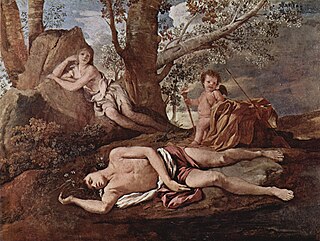
Echo and Narcissus is an oil painting of 1627 and 1628 by French artist Nicolas Poussin. It measures 74 by 100 cm and is kept in the Louvre, Paris.

A Blonde Woman, also called Flora, is an oil painting by Palma Vecchio, dated today to around 1520, but undocumented before 1870, in the collection of the National Gallery, London.

The legendary rape of the Sabine women is the subject of two oil paintings by Nicolas Poussin. The first version was painted in Rome about 1634 or 1635 and is now in the Metropolitan Museum of Art in New York City, catalogued as The Abduction of the Sabine Women. The second, painted in 1637 or 1638, is in the Louvre in Paris, catalogued as L'enlèvement des Sabines.
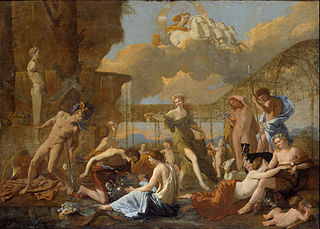
The Empire of Flora is an oil painting by Nicolas Poussin, dated to about 1630 or 1631, which is now in the Gemäldegalerie Alte Meister in Dresden.

Flora Caressed by Zephyr, also titled Dawn (L'Aurore), is an 1802 oil painting by François Gérard which depicts the love of Flora (Spring) and Zephyr from Graeco-Roman mythology.
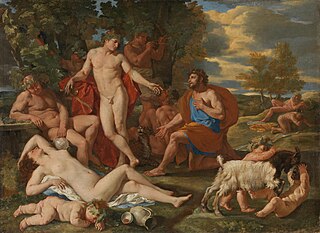
Midas and Bacchus is an oil painting usually attributed to Nicolas Poussin and dated to about 1624–1629, which is now in the Alte Pinakothek, Munich.

A Bacchanalian Revel Before a Term is an oil painting by Nicolas Poussin, dated to 1632–1633, which is now in the National Gallery in London.



















